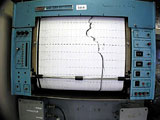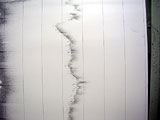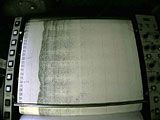

 | |||||||||||||||||||
|
|
Journals 2006/2007Miriam Sutton
August 12, 2006 AM Location: Makkovik Bank (55° 37' 46.19" N, 57° 22' 01.43" W) The camera and grabber were stowed away and the seismic equipment was launched over the stern for a full day and night of bouncing sound waves off the seafloor. The scientists use four different types of seismic equipment to measure the sound waves as they are transmitted and received from the seafloor and the underlying substrate. The technology generates a view of the various layers of sediment found beneath the seafloor that can be viewed graphically and digitally. Each instrument has unique characteristics and collects the data by generating and measuring different wavelengths of sound. The sound waves being used by the Geologic Survey of Canada scientists meet the environmental standards and are not considered hazardous to marine mammals. Two of the seismic instruments (the 3.5kHz and the 12kHz) use high frequency wavelengths which provide the scientists with a graphic image of the seafloor. The length of these high frequency waves is too short to penetrate much below the seafloor. The 12kHz image is limited to the seafloor surface and the 3.5kHz signal penetrates the seafloor to about one meter below the surface. (See 3.5kHz and 12kHz photos below.)
A third seismic instrument, called the Huntec, works on a lower frequency and penetrates about 100 meters into the seafloor. The Huntec's frequency settings also provide the scientists with a more detailed image of the seafloor sediment. The fourth seismic instrument is known as the Air Gun. The Air Gun is set on a low frequency which provides a longer wavelength that can record up to 1 kilometer (about 1/2 mile) into the seafloor sediment. However, the Air Gun does not provide as much detail about the sediment as the Huntec. (See Huntec and Air Gun seismic photos below)
Today's activity: (Ask a friend to join you in this activity to demonstrate the varying wavelengths created with energy.) You and your partner should each hold onto one end of a jump rope (or similar rope) and stand apart so that the rope is sagging in the middle. Move the rope up and down on one end of the rope to send a wave to the other end of the rope. Observe the size of the wave moving along the rope. Next, change the rate (or frequency) at which you move the rope and observe the changes in the length of the waves as they move from one end of the rope to the other. Discuss how this demonstration can be applied to the sound waves scientists use to penetrate the seafloor. Word of the Day: Substrate REMINDER: Record today's Sea Surface Temperature (SST) and the Air Temperature on the data table you created from the August 05 journal entry. |
||||||||||||||||||




